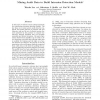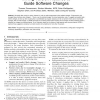91 search results - page 14 / 19 » Mining frequent item sets by opportunistic projection |
PAKDD
2005
ACM
14 years 1 months ago
2005
ACM
We define sporadic rules as those with low support but high confidence: for example, a rare association of two symptoms indicating a rare disease. To find such rules using the w...
DMKD
1997
ACM
13 years 11 months ago
1997
ACM
Clustering in data mining is a discovery process that groups a set of data such that the intracluster similarity is maximized and the intercluster similarity is minimized. These d...
KDD
1998
ACM
13 years 12 months ago
1998
ACM
In this paper we discuss a data mining framework for constructing intrusion detection models. The key ideas are to mine system audit data for consistent and useful patterns of pro...
ICSE
2004
IEEE-ACM
14 years 7 months ago
2004
IEEE-ACM
We apply data mining to version histories in order to guide programmers along related changes: "Programmers who changed these functions also changed...." Given a set of e...
PAKDD
2004
ACM
14 years 29 days ago
2004
ACM
Although the task of mining association rules has received considerable attention in the literature, algorithms to find time association rules are often inadequate, by either miss...


